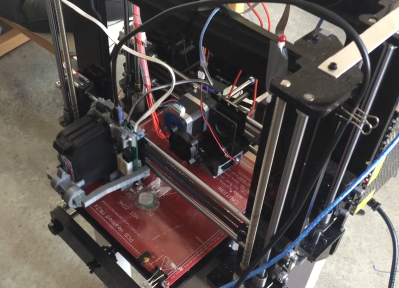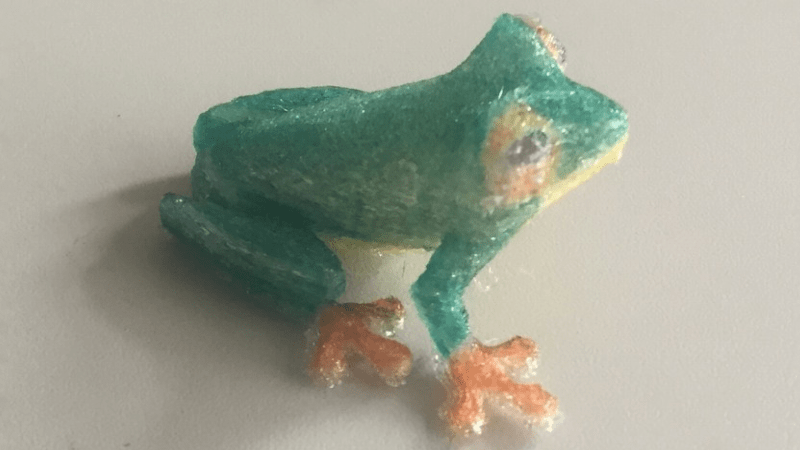3D printing is a popular process, though one of the hangups is that parts are typically produced in just one flat color. [Aad] has been working on a simple modification to his Prusa i3 printer, however, that enables the production of full-color parts.

The hack is simple, consisting of a second vertical frame added on to the printer. Rather than mounting a second extruder, however, there’s a inkjet printer head delivering CMYK water-based inks. After the main extruder lays down each layer of clear PLA plastic, the print is then moved under the inkjet head, which lays down colored inks before the next layer is printed, as seen in this print video.
[Aad] notes the results are presently imperfect. The ink seems to bleed between layers, mixing with the plastic after it is laid down. Further testing with different inks and filaments is in the pipeline, however, aiming to improve quality and contrast of the results.
We’ve seen other approaches to the color 3D printing issue before, too. Video after the break.
















Maybe a solvent borne ink would bond to the pla better?
Tbh when I read the headline, I thought that they were injecting dye into the hot end. That would probably result in much more consistent prints, but I have no idea how feasible it would be. Flashing of any liquid vehicle for the dye would certainly be an issue. Maybe deposit the dye on the filament directly, right before it enters the hotend? That would allow the vehicle to flash off before it gets incorporated into the melted plastic.
Ideally, you’d mix powdered dyed pla in at the hotend, but dispensing controlled amounts would be problematic.
I’m pretty sure one of those is what is patented and used by Stratasys, to jerks of the 3d printing world.
This really has been around for quite some time and with better results the XYZ da vinci color pro printer
Mimaki and Disney have a lot of newer patents in this area too.
;-)
They should test with nylon. Nylon is able to absorb dye a lot better than PLA. As for tinting the PLA before entering the hotend, you’ll have a lot of issues to solve, like how many plastic is there in the hotend to extrude before the color actually exits the hotend. What about all gradient colors you don’t actually want ?
One might think that tinting before the hotend is possible only if the tint is done while the infill is printing and should never change when printing the exterior wall, but this is wrong too, since you might want clear color changes on the exterior skin.
(Well, it might be possible to hack a slicer to actually enter the infill area on an abrupt color change so the not so clear plastic is not visible, but AFAIK, it’s not done yet)
Absolutely no technical details on the implementation of the print head? Seriosly?
It looks like an HP ink cartridge that I’ve seen used in various other non-printer projects.
This really has been around for quite some time and with better results the XYZ da vinci color pro printer
The color print head is the HP23 from Hewlett Packard. The colorpod unit used is the same as used for the powder based 3d printing. For some of the black and white samples I used solvent based ink from the HP45 cartridge.
Yeah, I opened the article mostly to see how they were controlling the printer cartridge.
Hi, I’m developing compounds highly filled with ink-adsorbing materials. I would be glad to verify if it works with your creative device. Just drop me an email. Claudio
Is this material in the form of 1.7mm fillament?
Yes
I Don’t want to spoil the fun as this is a very cool concept, but I always associate inkjet printer with expensive (the ink, although those costs are mainly artificial, I’m aware of that) and troublesome (inkjet nozzles being clogged if not used often enough). And not being able to print at all (a simple black and whit text document in black) when a completely different color is missing/empty.
So despite this project being very, very cool, I need some time to process this info.
But, seriously, this project is very cool, did I mention that?
The biggest problem in the setup is the oozing of the extruder while it waits for the inkjets
I’m still waiting for creality to come up with an affordable version of this. It is not new, it is how the XYZ printing da Vinci Color works, but that is out of the price range of a mear-mortal-on-a-budget hobbyist.